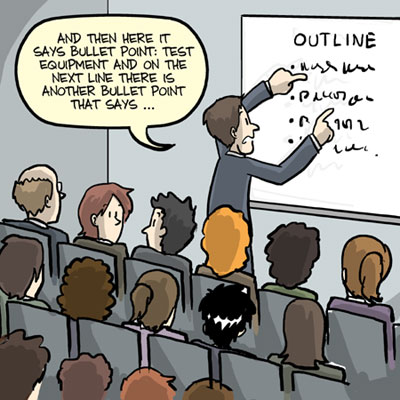 Oral presentations are a richer medium than written documents. They allow you to establish stronger contact with the audience and better convince them of your viewpoint through verbal and nonverbal delivery, as well as the ensuing interaction. Oral presentations have a price, however, in terms of the audience's time. If you give a poor 15-minute presentation to an audience of 200 people, you have wasted the equivalent of 50 hours of work — more than a week of someone's work time. Preparing effective oral presentations, like writing effective scientific papers, takes time, but it is time well invested.
Oral presentations are a richer medium than written documents. They allow you to establish stronger contact with the audience and better convince them of your viewpoint through verbal and nonverbal delivery, as well as the ensuing interaction. Oral presentations have a price, however, in terms of the audience's time. If you give a poor 15-minute presentation to an audience of 200 people, you have wasted the equivalent of 50 hours of work — more than a week of someone's work time. Preparing effective oral presentations, like writing effective scientific papers, takes time, but it is time well invested.
Still, many oral presentations are ripe for improvement. Think of the last large conference you attended. With typically three to four talks an hour, eight hours a day over several days, such conferences can expose you to dozens of presentations. What fraction of these delivered a message that was useful to you (that is, how many of them did more than simply provide a great deal of complicated information)? What fraction of the presentations did you find fascinating (that is, how many got your undivided attention from the speaker's first word to his or her last)? An effective oral presentation gets you to pay attention, to understand, and to think or do things differently as a result of it.
This unit will help you prepare and deliver more effective oral presentations in English. It will help you select and organize a presentation's content, create slides (if appropriate), deliver the presentation, and answer audience questions. It illustrates each of these tasks using three example presentations, which exemplify different levels of specialization.
- The first is a 15-minute conference presentation by John Creemers on "PREPL, a putative oligopeptidase deleted in patients with hypotonia-cystinuria syndrome." It is clearly meant for a specialized audience, yet scientists from other fields should be able to understand the overall story presented.
- The second is a 10-minute presentation by Marie Verbist on her "Automated alignment procedure for stitching with a focused ion beam" to an audience of fellow PhD students. Because the attendees can come from all fields of science and engineering, Marie's presentation is less specialized than John's: it is meant to spark interest for her work in everyone present.
- The third is a six-minute presentation by Jean-luc Doumont on "What you should know about TeX" to an audience of scientists. For this short, nontechnical presentation, Jean-luc chose not to use slides.
You can watch all three presentations in the section Delivering Your Oral Presentation.